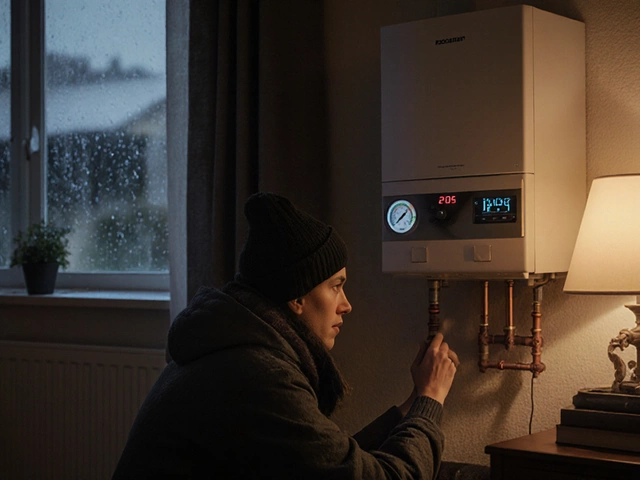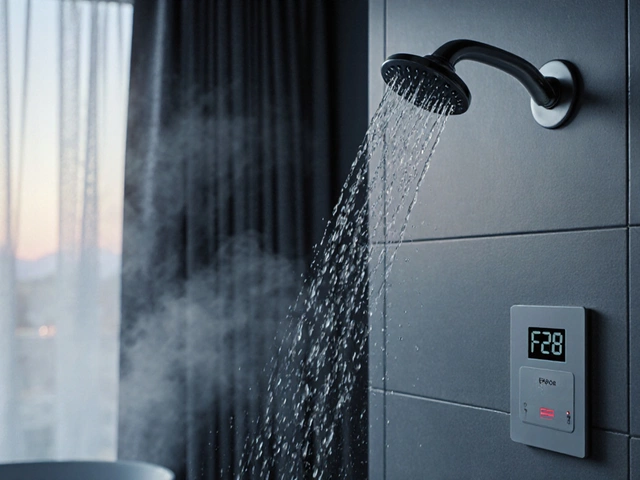So you popped that casserole in the oven, set the timer, but an hour later it’s still stone cold? Yeah, that might be a sign your oven’s heating element is toast. Before you panic, replacing this tiny but mighty part is often far less costly than you’d think. But what’s the damage to your wallet, exactly?
First, you gotta know what you're looking at money-wise. On average, it might run you between $30 and $60 for just the part. Not too bad, right? Now, if you’re not the 'DIY-type,' hiring a pro could bump that up to $150 to $300, depending on your locale and the model of your oven. Still cheaper than a new appliance, for sure!
Want to give it a go by yourself? Most elements are pretty straightforward to switch out. It’s like changing a light bulb—if you know where to find the screwdriver in the junk drawer. Seriously, a few unscrews, a pull, and pop in the new one. However, if your oven’s making sad noises or there's a weird smell, calling in the experts might save you a headache—or a finger.
- Signs Your Heating Element Needs Replacement
- Understanding Replacement Costs
- DIY vs Professional Repair
- Where to Buy a New Heating Element
- Tips to Extend the Lifespan of Your Oven
- When to Call in a Professional
Signs Your Heating Element Needs Replacement
Wondering if your oven heating element replacement is overdue? A few clues might save you from a cold dinner. First up, if your food takes ages to cook or comes out unevenly baked, your heating element might be on its way out.
Peek inside the oven. A working element should glow red hot when in action. No glow? That's a big red flag. If you’re hearing strange buzzing noises or spot sparking, it’s a sure sign something's amiss.
- Uneven Heat Distribution: If the oven temperature seems inconsistent—like overcooked on one side and undercooked on the other—your heating element could be wearing out.
- Physical Damage: Check it for blisters or breaks. Damages like that usually mean bad news.
- Cold Oven Syndrome: If it's putting out as much heat as a cool breeze, it's definitely time for a replacement.
- No Red Glow: The element should glow a nice even red when turned on. A no-show red means it's done.
According to The Appliance Analyst,
'The heating element is one of the most common causes of oven issues, but thankfully, it's also one of the easiest things to check and replace.'Taking a few minutes to inspect can save you a lot of guesswork.
Sometimes, it's the subtle signs that are easy to miss. A little patience and regular check-ups can keep your oven happy and you out of repair shops.
Understanding Replacement Costs
Thinking about replacing your oven's heating element but worried about the price? Let’s break it down. If you’re doing it yourself, a new oven heating element replacement usually costs between $30 and $60. However, the price can fluctuate based on the oven brand or model. Say you’ve got a fancy European oven; it might cost you more since parts for these can be priced higher.
Now, if you’re not the handy sort and you’d rather call a technician, expect to add labor costs into the equation. Labor alone can be anywhere from $50 to $150. In bigger cities with higher living costs, you might see those prices rise even more due to demand. It's just the nature of the beast!
Here’s a quick rundown of what your total might look like:
| Cost Type | Estimated Price |
|---|---|
| Heating Element Part | $30 - $60 |
| Labor (if hiring a pro) | $50 - $150 |
| Total (DIY) | $30 - $60 |
| Total (with Professional) | $150 - $300 |
And remember, if you suspect more damage—like wiring issues—it might cost more, so check that first. Most folks save money by doing a bit of research or asking around for the best-priced parts.
"Repairing rather than replacing an appliance can save you hundreds, sometimes thousands," says John Decker, a seasoned appliance technician with over 20 years in the business. "But always know when something is beyond repair, that's when replacements come in."
Another thing is that online shopping offers a great variety of parts. Websites like Amazon or Repair Clinic have sections just for appliance parts, often carrying compatible options that fit your oven perfectly, at a competitive price too.
DIY vs Professional Repair
Alright, let’s get down to it. Should you roll up your sleeves and replace that oven heating element yourself, or is it time to call in a seasoned pro? Both options have their perks, and it mainly depends on your comfort level and maybe how deep your pockets are.
Doing it yourself can save you a significant chunk of change. If the issue is just a dead heating element, you can likely fix it with a little patience, a good how-to video, and a screwdriver. It mostly involves removing the back panel, disconnecting the old element, and popping in a new one. If you can handle IKEA furniture, you’re probably golden here.
Here’s a quick checklist for DIY replacement:
- Turn off the power at the breaker box, not just on the oven itself. Safety first!
- Get the right replacement part. Model numbers are your best friend here.
- Have basic tools ready—usually, you’ll just need a screwdriver.
- Be cautious but confident. Mistakes can happen, but they're often fixable.
However, if the idea of dealing with electrical stuff sends a shiver down your spine, no worries! Professionals are there for a reason. They bring peace of mind, and sometimes that’s worth the extra coin. Consider hiring a pro if:
- Electrical work isn’t your thing.
- Your oven is still under warranty (you don’t want to mess that up).
- The problem persists after replacing the element. It might not be the element at all.
- You’ve got a fancier setup like a wall oven where access is tricky.
Here’s a bit of number crunching. According to a 2024 appliance repair survey, those who opted for DIY claimed to spend on average $45 for the part alone. In contrast, those choosing the pro route reported an average expense of about $200, including parts and labor. So weigh the price against the value of your time and stress levels.
Deciding between DIY and professional repair varies for each person. If you enjoy a hands-on approach, DIY might be gratifying and lighter on your wallet. But there's no shame in calling the cavalry for a stress-free fix. Either way, having options is key to making the best choice for your home and budget.

Where to Buy a New Heating Element
Alright, now that you've decided to get a new oven heating element, the next step is knowing where to find one. It's not as tricky as it sounds. You just need a few trusty spots.
First off, let’s talk about local appliance shops. These are often the hidden gems when it comes to tricky parts. Not only do they usually stock what you're looking for, but their staff can also offer some real-world advice specific to your oven's brand and model. Plus, supporting local businesses is always a win!
However, if taking a trip to the store isn’t your thing, or you just can’t find that rare part locally, going online is your best bet. Websites like Amazon, eBay, and specific appliance part stores like AppliancePartsPros or RepairClinic have a wide selection of elements. Most of these sites have handy tools where you can plug in your oven’s model number to ensure you’re getting just the right part.
Another online perk? Prices can be pretty competitive, and you can easily compare across sites. Don’t forget to check for customer reviews to avoid unwanted surprises. Just remember to set aside a few days for shipping.
A little pro tip: keep an eye out for the brand name elements. These are designed to fit your oven perfectly and often come with a warranty. But if you're on a budget, third-party options could save you a chunk of change. Just verify they’re certified and have good reviews.
Lastly, if you’re already working with an appliance repair service, ask them if they can source the part for you. Sometimes they get special deals or quicker delivery times due to their supplier relationships.
Tips to Extend the Lifespan of Your Oven
Your oven’s like your favorite pair of sneakers—take care of it, and it’ll take care of you. Keeping it in tip-top shape can save you cash and stress down the road. Wondering how? Let's break it down.
Start with regular cleaning. It sounds basic, but keeping the oven free from grease and spilled food can prevent a lot of issues. When gunk builds up, it not only affects performance but makes cleaning an ordeal. After every few uses, give it a good wipe down. Use a soft cloth and non-abrasive cleaner to avoid scratching surfaces.
Watch out for faulty seals. The rubber gasket around your oven door keeps the heat in, which is crucial for cooking efficiency. If it’s cracked or worn out, it’s time to swap it with a new one. This helps maintain the proper temperature without overworking the heating element.
Don't forget to check your oven’s temperature regularly. An easy way to do this is with an oven thermometer. If temperatures seem wonky, it could mean your sensor or thermostat needs looking at, which might save the oven heating element from overcompensating.
- Be careful with the oven door: Slamming it can mess with the hinges and seals—and yep, that affects heat retention.
- Follow the manual: We’ve all lost it, but finding it online can show you any quirks or specific maintenance for your model.
- Handle with care: Moving heavy pots in and out? Try not to bang them against the walls or door.
A little proactive maintenance goes a long way. If numbers are your thing, consider this: replacing a single element may cost around $30 to $60, but avoiding a major breakdown keeps more dollars in your pocket over the long haul.
When something quirky happens, like weird noises or uneven cooking, don't ignore it. Tackling small issues quickly can prevent a bigger bill later. Some pros say regular checkups every couple of years can also spot and prevent problems before they become costly messes.
When to Call in a Professional
Alright, so maybe wielding a screwdriver isn’t really your thing, or you’ve tried replacing the heating element yourself, and things got a bit messy. No worries, that’s exactly when you might want to call in a pro. Getting a professional on the job isn’t just about avoiding chores; sometimes, it’s the smart thing to do.
Here are a few signs it's time to bring in the experts:
- Strange Smells or Noises: If your oven’s making sounds more suited to a horror movie, or there's a burnt smell, it's best to not ignore these ominous signs. A professional can quickly identify if it's more than just the heating element.
- Repeated Fuse Blows: If turning on the oven feels like a game of roulette with your circuit breaker, there's probably a deeper electrical issue at play. Leave this one to the folks who won’t get singed by sparking wires.
- Unresponsive Oven: The heating element might not be the culprit if your oven’s playing dead. A professional can diagnose whether it’s a wiring issue or another component gone haywire.
- Complex Oven Models: Some newer, more complex oven models are finicky. Their smart features can be a bit delicate, and monkeying with the insides could void warranties or mess things up worse.
Of course, deciding to call a pro also boils down to comfort and confidence. Some folks dig the challenge of fixing things themselves, while others figure it's best left to someone who's got this down to a science—and that’s okay!
Now, talking cost, hiring someone might add to the bill, but think about it this way: Time and peace of mind are valuable too. The key is to do a little homework—get quotes, check reviews, and ensure your chosen service is certified to tackle electric oven repair. After all, there’s no harm in a little assurance!




